-
Posts
1,999 -
Joined
-
Last visited
Content Type
Profiles
Forums
Store
Help Articles
Posts posted by Peter Green
-
-
Tonight....Marinated Beef Salad with Lemongrass
Okay, call it what you like, this is Luk Lak (Which immediately sends my family off into Klingon impersonations, I'm sorry).
It's a two step dish. One, the marinade.
Garlic, ginger, lemon grass, and onion.
But, first, you need prahok.
Where do you find prahok, you ask? Good question. The fermented, pasty, smelly fish stuff of Indochina isn't something you just pop into the corner grocery and pick up.
Or is it......
Phia Sing's Traditional Recipes of Laos was prefaced and commented very well by the Davidsons. In there they point out that many a Lao who's ended up in the West has been surprised at their first taste of canned anchovies. "This is paa dek!"
So, having no other choice, I snagged some of Yoonhi's anchovie stash. She wont' miss one tin. ("Et tu, Caesar?")
So, we start by pounding down the anchovie to a paste in the mortar, and then add in the other ingredients above. Once they're beaten up enough, I transfer them to a bowl, add salt and sugar, and dump in a bunch of limes.
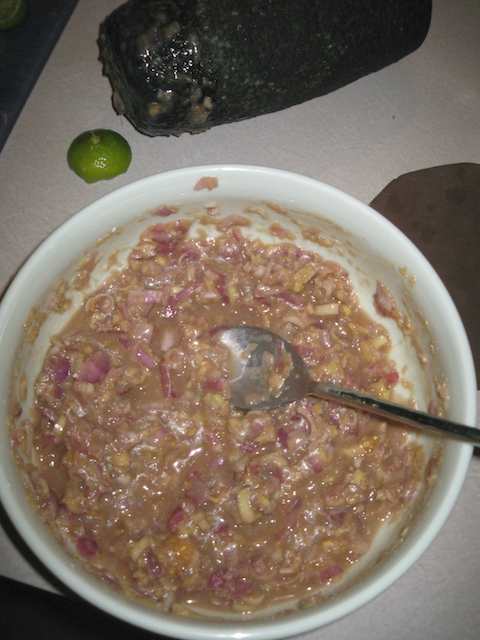
Then the meat goes in the marinade, and the limes work their magic on the meat.
The meat sits for an hour in the marinade.
Now, the plan would have been to separate the meat from the marinade, and then reduce the sauce to a thick gravy to be poured on the carpaccio of beef.
Unfortunately, Yoonhi has this thing about eating raw meats I prepare. So, as a compromise, I very lightly sauteed the meat so it was red, but not raw, and then separated the meat from the juice, and reduced it to get the gravy I wanted.
The meat was mixed up with coriander, mint, and cucumbers (I didn't use the peanuts or green beans), and then the gravy was drizzled on.
If raw, it would've been a lot like the buffalo tartare ( laap krouaille) we'd had in Luang Prabang last time.
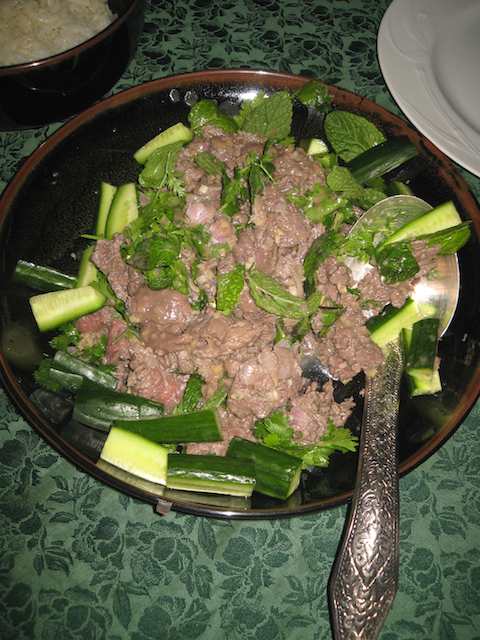
As was it was almost dead on for the luk lak I'd had before in Penh (which was cooked for Westerners, rather than served raw). Khmer Surin on R. 357 was always good for this.
Nice gravy, though. (And Yoonhi liked it, which is important).
-
Frizz Restaurant where Erin did her class has a nice little website with menus, discussions, and recipes!
-
Thanks, Erin! An excellent walk through!
Amok varies from place to place, house to house. I've had it like this (very much like a hor mok) and I've had others that were saucier, and others that were more like soups inside a coconut.
Maybe we need an amok cookoff?

I better get back in the kitchen before Yoonhi catches me out here.
-
Peter, is the rice wine shaoxing or something else?
They're not specific in the book. shaoxing is a fermented wine, and they suggest sake (which would probably indicate good mirin) as an alternative. They're thrust was that the light alcohol (relatively) of the wine allows the herbs "to release their flavour gently while the meat remains tender".
-
I mentioned earlier that Joannes' book was for Act for Cambodia.
As many of the readers are in the US, if you're interested in more information, then visit:
www.actforcambodia.org
(the website is still under construction, but the basics are there)
Or check out:
Act for Cambodia USA
712 Union Street
Brooklyn, NY 11215
email: info@actforcambodia.org
tel: 646-641-1567
-
Anyway, a perfect eg of Chinese culinary influence would be the popular Khmer noodle soup known as "kuyteav" (and...I think...in Vietnam as "hu tieu"). This was apparently brought over by Chinese immigrants.
General rule of thumb #42: If you see noodles or dumplings, then the Chinese have been around
You see a lot of noodles and dumplings everywhere.

-
Honey Glazed Chicken and Barbecued Beef Skewers
We started off in the stir fries, so I figured it was time to move to the barbecues and roasts.
For the chicken, the roasting is done clay-pot style. You chop up a mass of lemon grass, kaffir lime leaf, shallot, and garlic, and cook this first in the bottom of the pot.
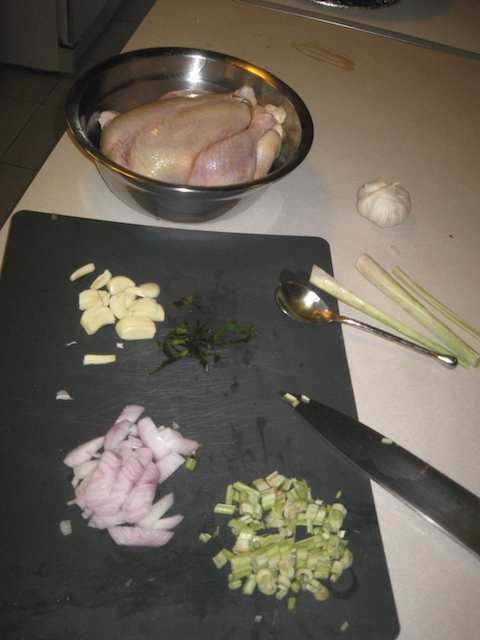
Meanwhile, you've rubbed your chicken down with a mix of honey and salt.
Once the aromatics open up, you drop the chicken in and cook it for five minutes with the cover on. Then add some rice wine, and cover again, cooking for an hour, turning it from time to time and adding more wine (somewhat how I like to be taken care of when there's a roaring fire).
Meanwhile, the meat is being prepped.

Black pepper, garlic, lemon grass, and shallots are pounded down to a pulp, and then mixed in soy and palm sugar, and used to marinate the tenderloin.
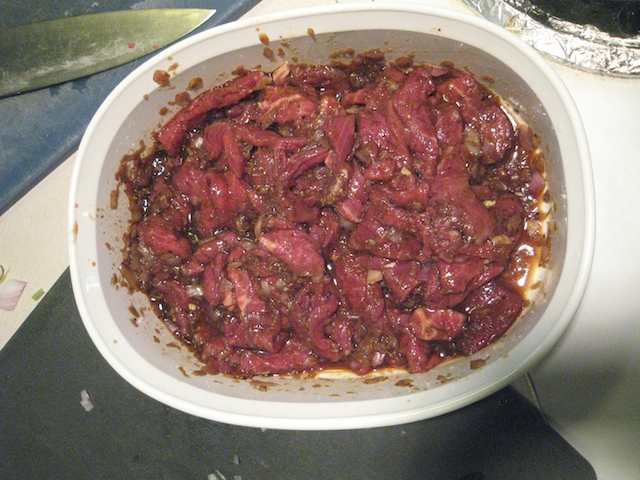
It then sits in the marinade for the hour the chicken is cooking.
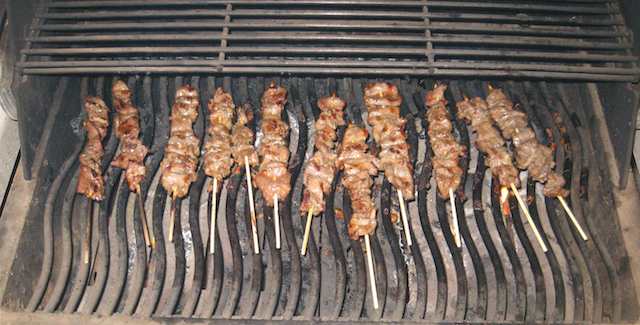
Towards the end of the chicken's roast, I pull the cover off the bird and put it back in the oven, and toss the skewers on the grill.
The result is mixed.
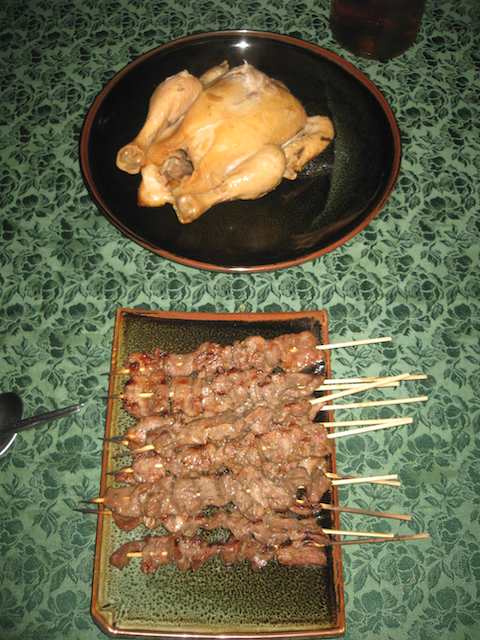
I really like the skewers. These came out just right, not cooked too much, but rather juicy, with the odd flavour combination that says "Indochina". I could eat a lot of these, but they do need rice, as the soy gives them a salty feel.
The chicken's another matter. Having cooked with the cover on, we don't get a really good glaze, and the flavours aren't strong enough to really impact you. There is an interesting thread of citrus in there, which must be the lemon grass and kaffir lime leaves interacting, but overall the meat comes out dry, and rather bland.
If I was to do this over again, I'd use my smoker rather than clay potting it in the oven. To be fair, the book does advise that the Khmer will put the clay pot over a wood fire to get the smoky smell, and I think chips in the smoker, with the aromatics in a separate bowl with wine below. Give it 3 hours in the smoker, and this could be really interesting.
The skewers were fine, but I'm thinking I should invest in a shallow metal trough and just start charcoaling things. That immediate presence to the heat is something I can't do on the barbie.
Overall, a good meal. But not as good was what we did last night.
Now, what'll I do tomorrow?.........
-
The tomato/pineapple combination is genius. Does anyone know when or how tomatoes made their way into Khmer cooking?
Tomato and green mango combination, I think you meant? Or do you mean the tomato pineapple we see a lot of? In both cases, my hats off to the chef who first came up with this matching.
I'll hazard a guess, and put the tomato down to the French, as the Khmer were cut off from the early imports by their neighbors to the East and West (hence the conspicuous lack of searing chilis in most of the dishes). I suspect that many a French officer would keep a small garden at his station for those items that were crucial to one's existence (I've a copy of Normal Lewis' A Dragon Apparent around here somewhere that I must reread).
-
Tonight's experiment Sweet Sour Fish with Green Mango and Pork with Ginger and Green Onions
This was a good combination, as the fish takes a while to cook, and the pork is pretty much on the spot.
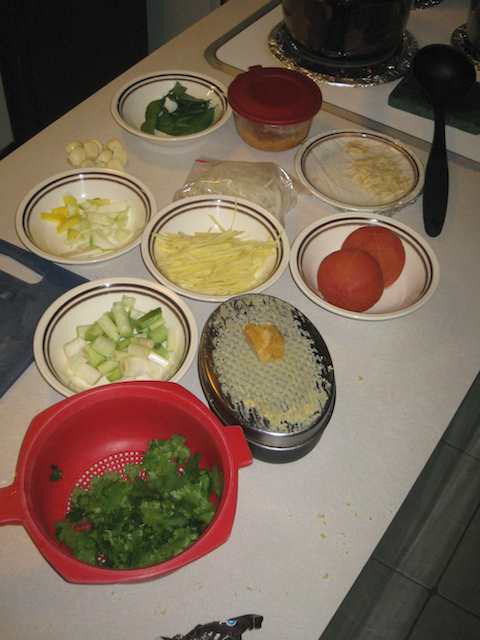
Fpr the sweet and sour fish, we prepped garlic, tomatoes (I removed the skin), 2 small green mangos (in slices), basil and coriander for garnish.
For the pork, we cut the pork in shreds. I only had belly at hand, but that's okay by me. And then we julliened a hunk of ginger and appropriated the whites of spring onion that were left in the fridge (the greens went somewhere else).
This sounded interesting, as they get the sour element not from vinegar, but from the green mango's tartness.
Oh, and I put Serena to work grating the palm sugar.
First the fish. Tilapia, because it, like myself, is cheap. (And it cooks through quickly)
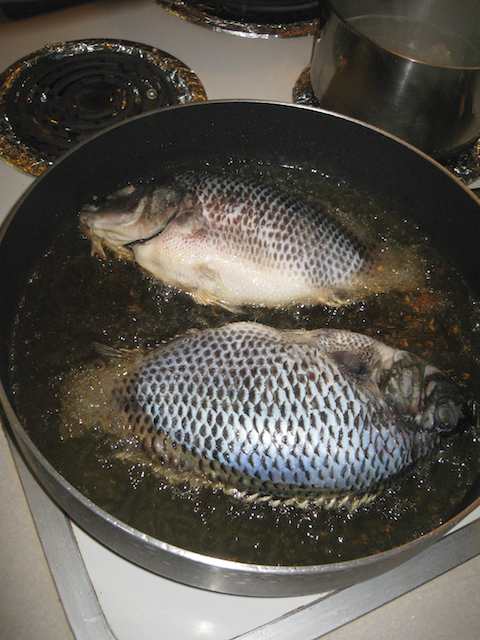
The fish is browned to gold, and then set aside.
Then, garlic, sugar, and fish sauce goes into the pan and is taken just to caramelization. At that point, you dump in the green mango, tomato chunks, and stir fry for "a few minutes". Once that's broken down a bit, you place the fish in there, lower the heat, and let it simmer for 15 minutes.
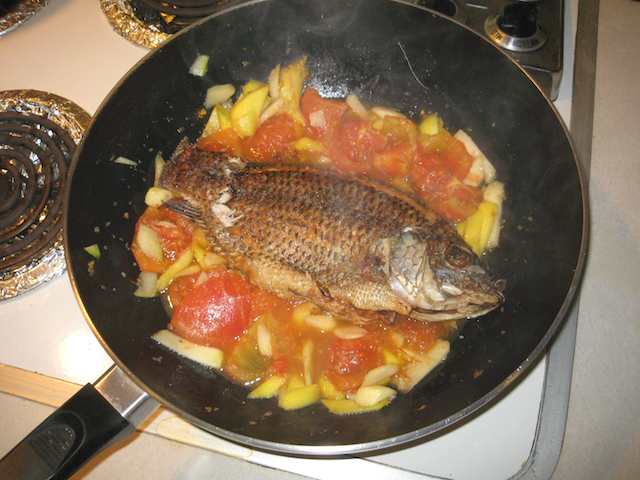
Once I'm within a 5 minute target on the fish, I start in on the pork.
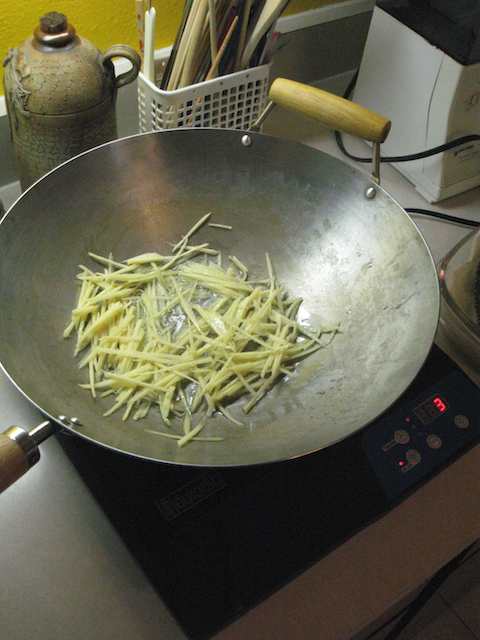
First, the Khmer treat ginger as a vegetable (it says in the book) "rather than a spice or aromatic". It gets a quick saute in the oil at medium heat, just enough to bring it to translucence. As this hits the oil, the entire kitchen lights up with a smell of ginger that just cries out "cocktails!" to me. (Yoonhi says everything cries out "cocktails!" to me, unless of course it's yelling "beer!" or "Maekhong!" or some other variant).
Then our beautiful belly goes in and the heat goes up. Get this belly browned, like a Nordic banker on the beach in Sihanoukville, and then add in the spring onion, soy sauce, and sugar, and finish the fry up. Add the basil, and remove it from the heat.
The fish gets plated,and the coriander and remaining basil goes on, wilting into the dish and opening up the aromatics.
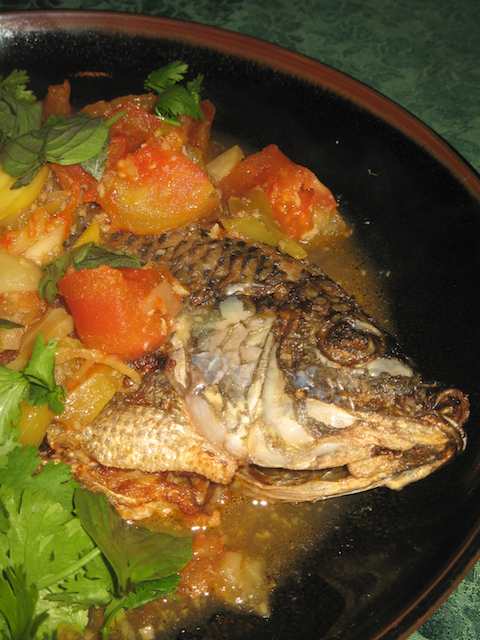
Yoonhi's startled by the green mango's tartness, balanced by the palm sugar. The flesh of the fish is very good, with the sauce's sweet and sour elements having penetrated into the overall flavour. This is in contrast to a lot of recipes that want the fish crispy, so the green mango sauce is kept separate until the end.
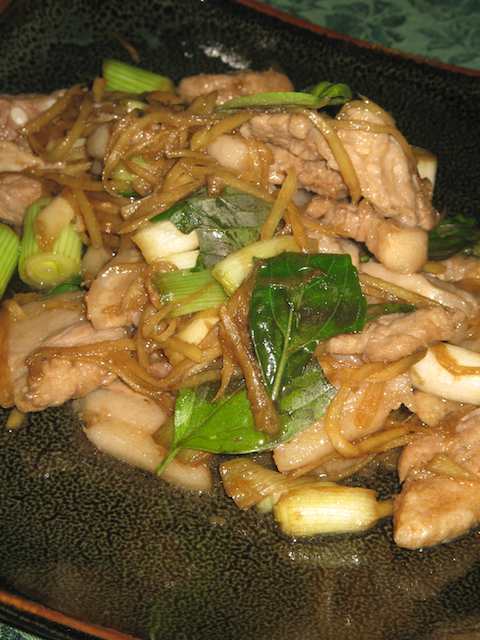
The pork....well, it is belly, so it's hard to go wrong. The ginger is very nice, done in this fashion, and the overall effect is very Chinese, but with that herbal fronting that distinguishes the Khmer dishes.
Both of these dishes would seem to have Chinese roots. The fish, as a sweet and sour, is more of an abstraction, the green mango being a good innovation.
The pork, being pork, is more traditional in many ways. The only difference (to me) is the sautee of the ginger, rather than juicing it and using it in the sauce or marinade. Pork, ginger, green onion....that all seems very Chinese to me (but what do I know?).
Both good dishes, and both fairly simple to put together. The fish, perhaps with a grouper so it would serve more, would make an excellent centerpiece at the next party, and the pork will keep everyone happy, although my one caution is that it has to be eaten quickly, as the fat does congeal in the air conditioning here.
There, that's it for today (at least from me).
-
 1
1
-
-
I did a cooking class while in Phnom Penh and cooked amok, Cambodian-style curry, and banana flower sausages, which were all delicious. I took meticulous notes and step-by-step photos for this forum, which I have never bothered to upload. Because I am lazy.
My favourite by far was the amok, which layered delicate slices of fish with a thick kroeung and coconut cream. When I had this dish in restaurants in Siem Reap, I was unimpressed, but when I made it, it was spectacular. I haven't had access to most of the ingredients since leaving SEA, but if anyone's interested, I'll post the photos and method here.
It's time to start posting, Erin! Amok is one of those comfort dishes that everyone loves. (and it used to be so good in Siem Reab!)
(I was just thinking about how to get the right coconut flavour without fresh coconuts)
-
I would second SnowAngel's recommendation - go to Ellen Shapiro's post. That'll give you an excellent overview of eating on the steppes.
That said, I wonder how much tradition the Inner Mongolian cuisine will have kept. It is one of those areas that was targeted (like Tibet) for massive Han Chinese repopulation.
Mind you, that could make it quite interesting.
My memories of Outer Mongolian cuisine - mutton for breakfast, mutton for lunch, and mutton for dinner. After a week in the field, back in the relative comfort of Ulaan Baator, we offered to take our Russian-Mongol guide out for a dinner of her choice - anything foreign.
She heavily recommended one Chinese restaurant, which sounded good.
Their specialty?
Mutton.
-
Is there a recipe for the Cambodian version of larb in there? That was the only Cambodian dish we ate that we really enjoyed.
I did a quick leaf through. No larb. There's a chicken salad, but it's sliced breast. Do you recall what they did that was different from Lao laab? Was this in Siem Reab of Penh?
-
Making La Fee Absinthe the French Way
I like the Evil Eye that La Fee uses in their advertising. Right down to the slotted spoon with that glaring Illuminati eye.
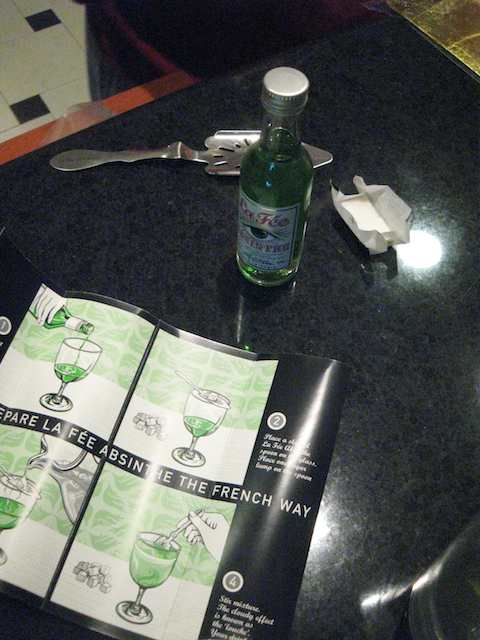
We were with friends in Bahrain for New Years ( which I really should write up) and they had a small bottle of La Fee, complete with full junkie kit of slotted spoon ( with eye) and sugar cube.
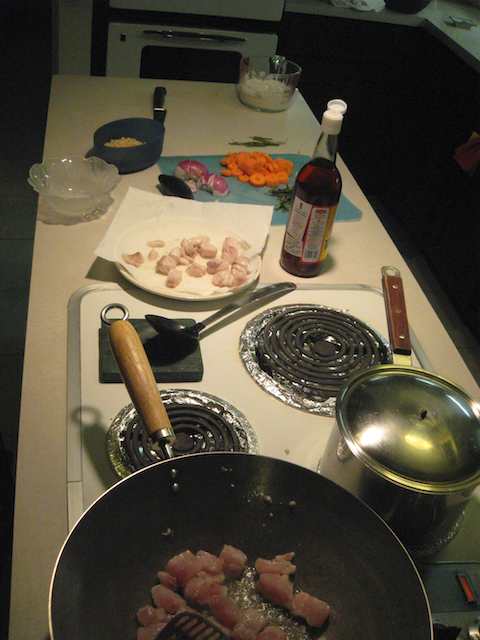
According to the instructions (this is breakfast, we follow instructions at breakfast) we first poured the absinthe into the glass.

then we did the junkie thing and prepped the sugar cube.

And then we poured hot water through the burning sugar.
Y'know, it was okay, but somehow I didn't quite feel like Hemingway in Spain.
Where'd that pink elephant come from?
-
I'll be following this topic with interest and participating whenever I can. I'm most interested in figuring out rice noodle dishes, which have always been my favorites at the (several) Cambodian places around town.
Peter, what else in that book looks interesting?
Chris,
I'll probably concentrate on the stir fries for the next couple of days (mainly because they're fast to prepare, and I know never to let a Korean go hungry).
The barbecues, however, look really interesting, with the reliance on pineapple in the marinades to soften the meat (but these are 24 hour preps, so they're for later).
The soups are also something I'm interested in, as the broths rely (again) more on herbs than the full frontal of some Thai dishes (although I still think it's hard to beat the comfort of tom kha kai).
And the rest, well, we'll see.

P.S. - As usual I'll cheat, and make use of my Khmer friends to advise!
P.P.S. - I forgot to mention (again) that Johannes Riviere's book is in support of the charity Act for Cambodia I'm a hard sell, but the Cambodians are one of those people I really do think we need to help.
P.P.S. - Also, as you cook crank up the Dengue Fever on the stereo!....Sleepwalking in Laos...Oh, yeah....
-
I've just gone through all 14 pages of Elsewhere in Asia, and there was not yet a thread for Cambodian cooking.
At least I don't feel frivolous.
Following on Rona's thread postings in the Eating in Cambodia thread , and the happy coincidence of finding the cookbook by the chef of Sala Bai, Joannes Riviere - Cambodian Cooking - I've decided to go on a Khmer cooking binge.
At least until the family mutinies (again).
Tonight was Shrimp with Black Pepper and Cilantro
The cooking is fairly straightforward, a quick stir fry, and suited to a worknight like tonight. Serena's off to ballet, Yoonhi steams some green beans, the rice is almost done, and my stuff is ready to throw in.
Drawing on Vietnamese influence, the beginning is caramelizing some palm sugar. Then I tossed in the prawns, a bit of oil, and garlic. Let the sugar glaze on while the prawns cook, and then, after 2 minutes, hit it with some fish sauce for salt, a tablespoon of fresh crushed black peppercorns (Thai, although I don't know if that makes a difference), and then a handful of cilantro/coriander leaves as I pull it off the heat.
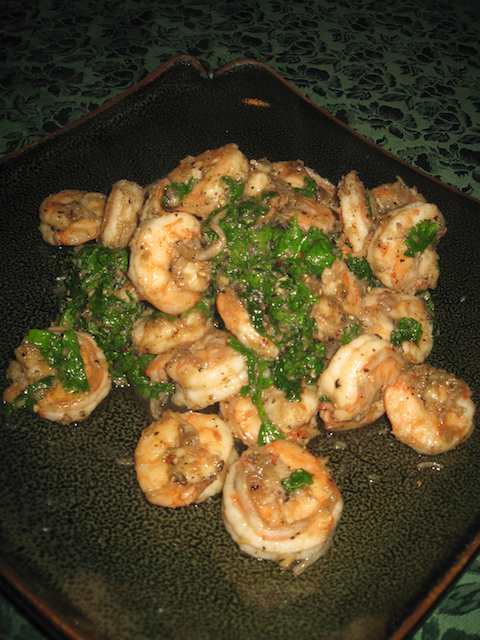
Like Riviere says in his book, these are not difficult recipes. In fact, most of them are perfect for a quick meal.
I like the contrast of this with many of the Lao and Thai things I do. which call for may more prep time (cooking is quick, but there's a lot of work in advance). The Khmer were cut off from overseas trade by their neighbors ("guns, why would you want guns? We'll protect you from those other guys") for ages, and this impeded the penetration of chili and other traded spices.
What I look for in Cambodian cuisine is more of fresh herbs and peppercorn, shielded from the burn of the Western neighbors, but still very distinctive from the Viets.
This delivers the fragrance of the coriander just opened up, and a bit of burn from the peppercorns and garlic. The prawns, to me, are an afterthought (but you've got to have something to digest!).
My only complaint is of my causing. I'd been too lazy to unlimber the MI unit (which entails shutting down the computers on this side of the house). Like most stir fries, this needed a higher heat than my ^%$^#$% electric range could deliver.
I wont make that mistake twice (five or six times, but twice is way behind me).
Edited for plurality
-
I can’t remember what we did for lunch, but for dinner we went to Sala Bai. This was the smallest of the three hospitality schools in Siem Reap. It’s run by a French organization that has been operating in Cambodia (or near Cambodia—they were helping Cambodian refugees in Thailand) since 1984, and since 1992, they have continued their work in Cambodia by focussing on education. Sala Bai is their hospitality school which opened in Siem Reap in 1992. It is completely free to students, and it relies mostly on funding from French government and private donors (the other two hospitality schools being Paul Dubrule and Shinta Mani which opened in 2002 and 2004, respectively). All three schools do wonderful work helping severely disadvantaged youths improve their lives, and I would recommend staying at one of them if you can. We wanted to stay at Sala Bai, but the manager feared the stairs would be too difficult for my mother to manage.
As a bit of coincidence, when I was in Vancouver I found something I'd been looking for - a Cambodian cookbook.
Cambodian Cooking by Joannes Riviere, photos by Maja Smend. This is "A humanitarian project in collaboration with Act for Cambodia". Joannes was he chef at Sala Bai, in charge of the training courses before moving to Meric at the Hotel de la Paix in Siem Reab.
The recipes are workable, the photos excellent, and it is for a good cause.
Peter’s catching up, so I must move quickly!"Catching up?" Hon, I'm done.

-
The Second Sitting – Part the Pub
Having left the restaurant at the tender hour of 8:30, I considered my options.
Option 1 – return to the room, pack, and sleep.
Option 2 – go to the pub for a last ale.
I’m a big fan of Sean of the Dead.
I returned to the Mason’s Arms, and ordered a badger. “A great nose on a Badger” and it is a fine beer. And the seasonal they have on tap, the Pickled Partridge smells of the Autumn.
This second trip was far better than the first. My enforced taciturnity helped immensely. It just troubled me that I’d not taken this stance at the very beginning. That was one meal lost.
Of course, there were a number of meals lost. It was a strange trip. Wake, work, work, work, then eat, and sleep, with only one meal on most days.
That’s quite unlike me.
As highlights - Hereford Road, Arbutus, and Gary Rhodes W1 were the meals that I enjoyed the most. Of the others, only that first meal was a loss, the others all had their good points (although I’m not sitting at those little wooden tables in GQR again. If I ever go back, I’m eating at the bar).
And so I turned off the lights on this set, and prepared for the next leg of the trip – Vancouver - which, in my proper state of confusion I’ve already written up ages ago.
There, I’m done.

”I just try to make everyone’s day a little more surreal.” Calvin & Hobbes
-
The Second Sitting – Part The Last
We left the empty high-rise, stepping out onto a wet Sunday night in London. The team and I hailed a cab, and set off back to our hotel.
I was earning black marks with my lords and masters, I suspect.
“We’d like to take the team out for dinner on Sunday.”
“I have reservations already.”
“Oh, but this will be fun.”
“Where and what is it?”
“It’ll be a surprise.”
“I hate surprises.” (I lied, so sue me)
“We were told not to tell anyone….”
“It’s Lebanese, isn’t it?”
“……..:
‘I didn’t come to London to eat Lebanese.”
“…….”
I should have not a team player inscribed on my tombstone.
And so I was dining alone again.
It was the last night, and I wanted to stay close to my bed.
I booked Locanda Locatelli. It was nearby at the Churchill, and would take care of the gap in my Italian dining for this trip.
They were waiting for me, and the dining room was surprisingly busy for this early in the evening. But the accents I heard were generally American (or Canadian - even I cant’ tell at times) and so this explained the earlier dining hours.
They didn’t offer a tasting menu, and, frankly, I was still happy from my lunch. I ordered a glass of Barbaresco (Cascin Saria 2001) and considered my options as I crunch on the breadsticks. There’s also a basket of buns and bread of different persuasions, and a green pool of Sicilian olive oil.
The wine list here is a marvel, covering Italy with a passion that’s….well….Italian. There’s one page just of Gaja. The rest of the volume works region by region, rather like the Italian sommeliers course did (I’m glad I took that. Italian wines were mystery to me before. Now they’re just an enigma).
I decide to go simple for dinner, without complicating matters. I start with the risotto with white Alban truffles.
The waiter hesitates a beat, and then advises me that it will take about 25 minutes to prepare. I smile. I expect no less.
I used the time to catch up on my notes, and listen in on the hum of the room. One family of four talks of their vacation to date, the two children extremely well behaved, obviously used to being taken places where they can eat well.
Around the corner from me I hear a fellow from Chicago complaining that his martini is Belvedere, rather than the “Kettle” he’d asked for.
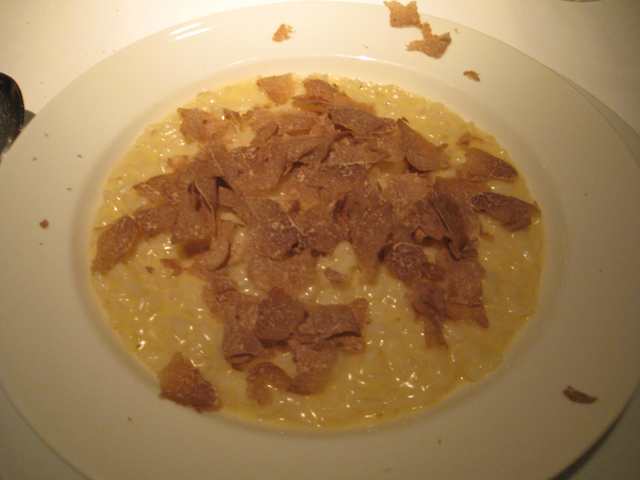
And in this manner, the half hour slips by. The risotto appears, and then the truffle is flourished and shaved with a certain mad abandon, the smell opening up as the flakes fall down to the hot rice.
A good risotto. Stirred with proper attention. I finish off all but one last grain, and police my table strictly for any trace of truffle.
For a second course, I revert to organs.

Pan fried calf’s kidneys, Rognone di vitello, lenticchie epure di patate
Creamy potatoes laced with lentils and a thick brown sauce, all as a canvas for the kidneys to rest upon. Trickles of crimson come out of the kidneys, providing a mirror of blood.
This is comfort food, indeed.
As a second wine I’d opted for an amarone della Valpolicella, Classico, Azienda Agricole La Giaretta. This is the right wine for the kidneys, all strength and power compared to the reserved nature of the Barbaresco.
I consider the post dinner drink menu, a splendid thing, with two pages of grappe alone, and more pages dedicated to brandies, acquaviti, distillati di Frutta, cognacs, armagnacs, calvados, and whiskey. There’s even a Welsh whisky – Penderyn Aur Gymru (and I can’t help but think of Blackadder’s line – “Wales? You need to carry an extra bucket of phlegm with you to pronounce the names!” – There, I hadn’t managed to alienate the Welsh up until now)
Somebody once told me that the Welsh allow home distilling, but you have to pay a tax in kind. There must be one great civil service office party in Anglesey.
Where was I?
Dessert. I passed. Some things looked good, but my flight required me to leave at 4:30 in the morning, and I didn’t want to be too heavy.
But, being Italian, they couldn’t quite accept that, and sent about a pretty little bit of petit fours to finish.
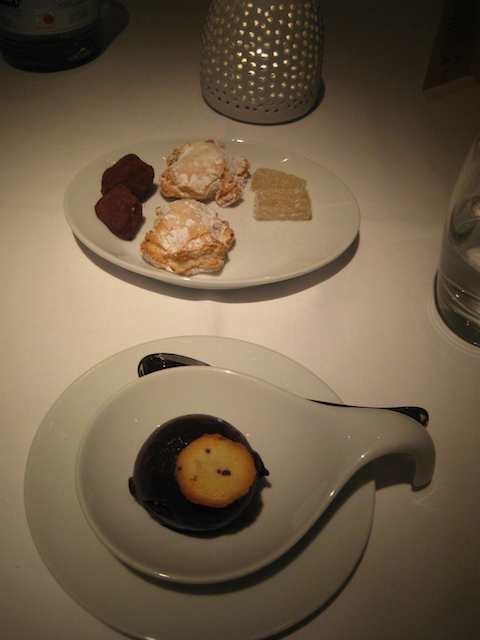
In the foreground is chocolate and banana, one of those combinations that you can’t help but admire. And behind, candied ginger, truffles with ameretto and grappe, and beautiful meringues that were all almond.
The nice thing about making your own ice cream is that you always have meringues about, too. You have to do something with those egg whites.
And so I finished.
My reaction? After what I’ve written, I’ll sound like a Philistine, but I wasn’t particularly impressed. Everything was good, but for real over the top Italian, I’ve had better in Bangkok at Giusto and Biscotti. Still, a comfortable meal, and it wasn’t my money (except for the wines), so I won’t complain too much. It’s just, with the hype of a Michelin star, the bar is raised.
We’re almost done
-
The Second Sitting – Part Six
Stuff on Sticks
It was a Sunday, and downtown London was quiet. Our work was winding up, and I found myself with the luxury of lunch, with some ninety minutes free in my schedule.
I flitted across the street to Soho, thinking that I might try something Italian. Quo Vadis in Dean Street had been suggested, so I set out in the rain.
But Sundays at lunch isn’t the best of times to find an open restaurant. My purpose shattered by their shutters, I fell into that panic that arises when I don’t know where my next meal is coming from.
Indian, French, Chinese, a horde of Japanese….
Japanese would do. Particularly yakitori, as that is quick, and not something I normally indulge in.
Bincho looked good, and I slipped into the empty restaurant.
I ordered a number of sticks - chicken thigh, wing, sweet pepper, pork belly, mushroom, and some salmon and prawns. The charcoal was in front of me at the bar, and the chef set about his business quietly.
I ordered a hot Akashi-Tai from Hyogo to take the chill from my bones (a honjozo, I believe), lingering over this while the meat cooked in front of me. Running my eyes down the bar, I spotted some more interesting things to eat.
Enoki bacon. Mushrooms wrapped in cheerful red bacon, the tiny enoki peeking out from the blanket of fat. How could I resist. I wish I’d brought the camera with me, but I hadn’t anticipated getting away for a meal.

They’ve a good selection of sake here. I leaf through their menu as I bite into the first of my yakitori.

(Not having the camera, the least I can do is make use of their sake descriptions)
As a second drink, I opt for a nigori. They have a Californian, and I’m quite interested in seeing how sake translates outside of Japan.
The mushroom – a shitake – arrives resembling a shriveled old granny, but is soft and juicy once bit into.
The nigori, from Takara in Berkeley, is a fine thing. Silky smooth.
I order a bit of fish to even things out – a mackerel, which arrives with that graceful S you achieve by threading the fish on a stake.
This was a good choice for a lunch. The sort of meal you can stretch out or contract to fit your schedule.
I had a little bit of time before heading back, and so I questioned the manager on the state of business.
Business is starting to hurt. Much of London’s restaurant trade (at least here in the centre of things) is driven by expenses, and expense accounts are drying up. Sake, as well, is being hit hard, as the big push for sake came earlier in the year, when the market was on the upswing, and everyone was looking forward to a rich future. The sake producers came at that time with their product, and pushed for the high end of the market.
Now, with recession being mouthed amongst the denizens of the City, sake is finding that the niche they wanted to occupy has dried up and blown away.
This isn’t good. With sake production slowly losing ground in its native Japan, the hope for the industry was to have been expansion in foreign markets.
We’ll see.
A bleak note to leave a restaurateur on, but I needed to get things done. If business brings me back, I’ll need to stop in here again to work my way through their tastings.
Perhaps Let's Drink Our Way To Prosperity would make a good motto for me?
-
The Second Sitting – Part 5
Gary Rhodes W1
I enjoyed my meal at the Brasserie the other night, so I felt Rhodes deserved a reprise. I’d dropped by on the way home the night before, and had made a reservation for one for this evening. With my focus on sensible, casual dining the first few nights, I felt now was the time to balance the scales with something a bit more posh.
Plus, my expense account was embarrassingly light.
I have a reputation, after all.
Our work being complete at a reasonable time that day, I was able to wash and change for dinner. I arrived to find them just setting up, the restaurant deserted.
Maybe I’m overly zealous.
I thought about the menu, but then just decided to leave it to them. They have a seven course degustation for seventy-five sterling, with wines paired for another thirty-five. Amuse, 3 starters, 2 mains, sorbet, and dessert. The difference between this and the eighty-five pound version is the cheese course, and I wouldn’t want to push my creaky infrastructure much more, the way I was feeling today.
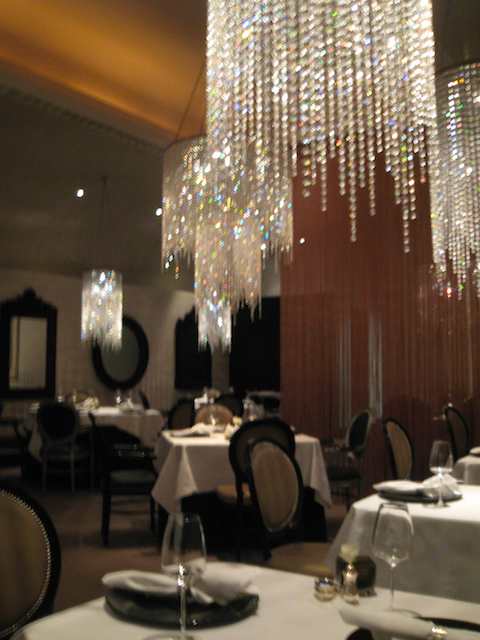
It’s a very solid room, a mix of modern and antique. Clean lines with antique French furniture. Big dangling Spina chandeliers (to give the impression of champagne bubbles rising), and lots of velvet. The heavy wood-framed mirror look Indian in their mass. Setee style couch sitting along the edges to bring out the languor in the clientelle.
There’s seating for perhaps 50 or 60 covers, about the same as last night, but spread out over four times the square footage.
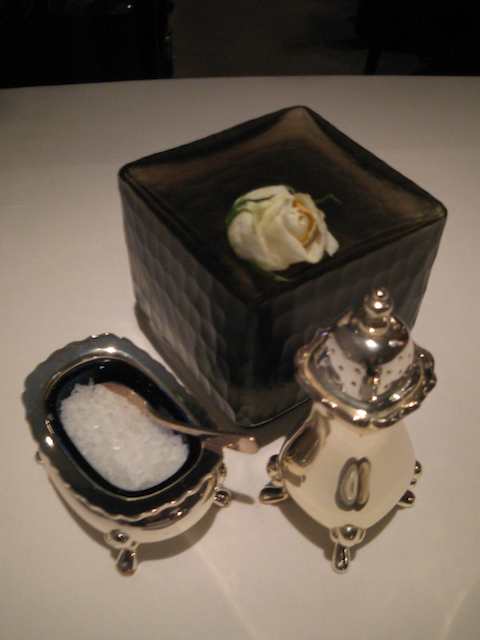
The service is all proper silver. The salt in a salver. I like touches like this. Fine dining isn’t just about the food, but about atmosphere and the tactile nature of the tools we use.

And I’ve already done my raving about British baking, so I’ll contain myself.
I settle down in solitude. It’s 7 p.m. Nothing outside of a bar is crowded at 7 p.m. in London.
I asked them to keep the dinner a surprise. I like suprises. And with no throng yet, the kitchen has all the time in the world to play with things.
It’s a Gary Rhodes restaurant (it’s hard to miss that), but the head chef here is Paul Welburn, late of 30 St Mary Axe. Mr. Welburn is doing British cooking, but with a “heavy French influence”.
So, with that description, how to begin?

Baked potato, cream cheese and chives
The amuse, with a baked potato foam, is a good start. The chive wafer braces the opening, while the chive jelly, when you work down to it through the layer of cream cheese in the middle, is the right flavour to complement the baked potato essence in the foam. It’s a pretty little think, one of those reconstructions that does live up to the title of an “amuse”.
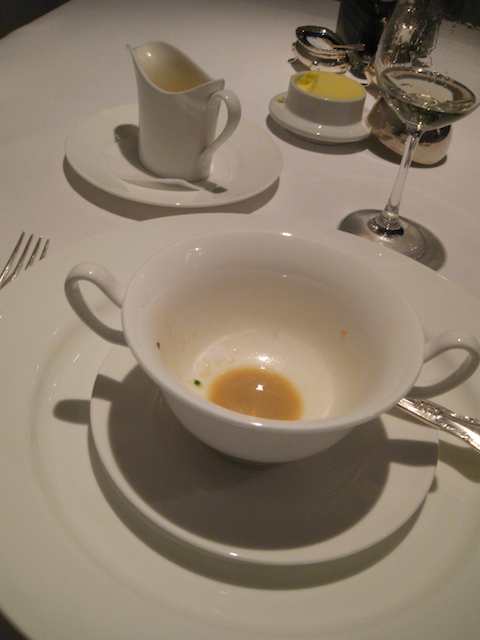
Roasted langoustine bisque Fennel and confit tomato
As you can tell, I quite enjoyed this. I allowed myself to get a bit too excited, I’m afraid, and forgot the camera until it was too late. Picture an orange brown bisque surrounding a stack of pink red langoustine, white vegetable shavings, and a long fat ‘chip’ of compote tomato.
The flesh of the langoustine was just right, having turned over (just) from the flaccid to lightly set. The fashion for nigh-raw lobster has never done much for me.
I had this with my first wine, the white Bordeaux Chateau Le Thil, 2004 The bisque itself was a little thinner than I’d expected, but was extremely smooth, with the roasted crustacean smell settling me comfortably. Against this, the Thil was a crisp, fresh note.
I do like the Thil. After chasing away the heaviness of the soup, it lingers in my mouth. I could drink a lot of this wine, but I probably shouldn’t. There’s more to come.
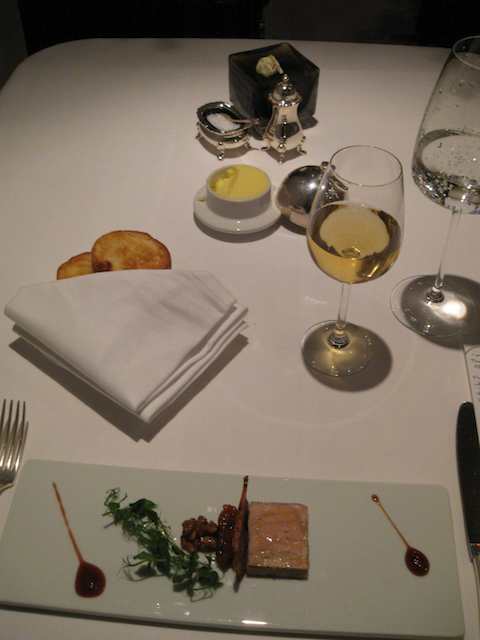
Terrine of foie gras spiced pear compote, candied walnuts and pain d’epice
My next wine arrived, a Les Pinots D’Alsace, 2006, Bott-geyl, Alsace. It’s a little dry, which should help in pulling out the flavour from the foie gras.
The room is beginning to fill out at this point, and the clientele are a varied lot. The women are beautifully done up. One table of middle-Eastern ladies (a mother and her daughters?) look stunning in their wraps and hats. The sparklies are probably well up in the double digits of carats, and there are some pieces there I know Yoonhi would very much like to have (one ring, it looked to be a topaz, covered the back of a hand). The men, in counterpoint, distributed at other tables with their fashionable better halves, left me looking the best dressed in the house. It just seems wrong to be wearing blue jeans in a place like this, but it appears to be the style now.
Working through my pate with the toast, I’m in a very happy place. Much of the grimness that haunted me through the first days here has passed.
The Alsatian roosts in the top of my palate, holding onto the tip of my tongue.
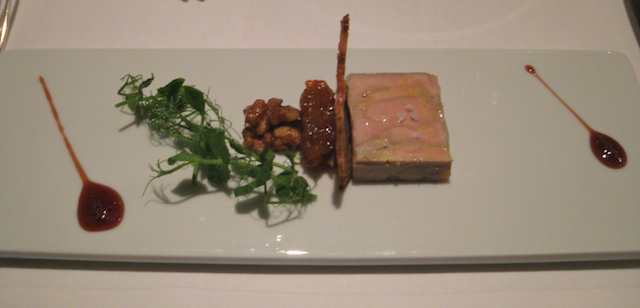
“Did you enjoy your the terrine of foie , sir”
“How can any human not enjoy foie gras?”
My new friend, the young sommelier who’d assisted in the wine for the snails the other night, is happy to see me back, and he’s obviously enjoying himself in working out the wines for the evening.
Another table is filled out, and I’m relieved to see men in jackets and tie. I’m not a fashion outcast after all, it would seem.
The next wine is very interesting. A Cotes de Jura “les Sarres” Savagnin, 2003, Rijckaert, Jura, in the NorthEast of France. Very high in minerals, and very different, with a bit of nuts in there.
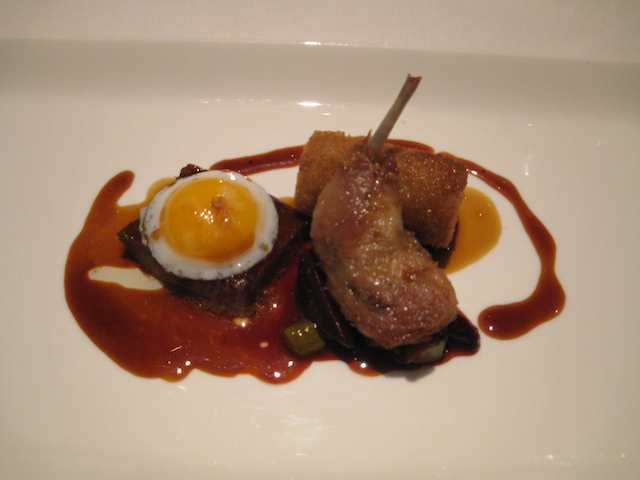
Confit quail, braised ox tongue beetroot and reform jus
This wine is a good match for the strength of this next dish. It stands up to the thickness of the egg yolk that spills over the ox tongue. From beneath the quail, the beet root oozes an appealing pool of faux blood, and the quail itself is superb, having been reconstructed back about the bone.
What I thought was a croquette propping up the fowl is instead a spam-like thing that I quite like.
As I said, this is a dish of strong flavours and thick textures, but the mineral hardness in this Jura can hold its own against the egg and spam. This is a wine I’d like to try with some Asian dishes, perhaps Khmer, with its emphasis on herbs rather than chilis?
I take a moment to contemplate the noble egg. As Cyrus Toddiwala said, “the egg is a happy thing”. (At least I think Cyrus said that. If he didn’t, he should have. He loved his eggs). A sunny disposition, the egg is like a smile. Once you start smiling, you can’t help but lift your spirits. Celina Tio, as well, subscribed to the belief that the egg was the perfect food, carrying its own sauce with it where ever it goes.
We’ve now completed our three starters, and step to the fish dish.
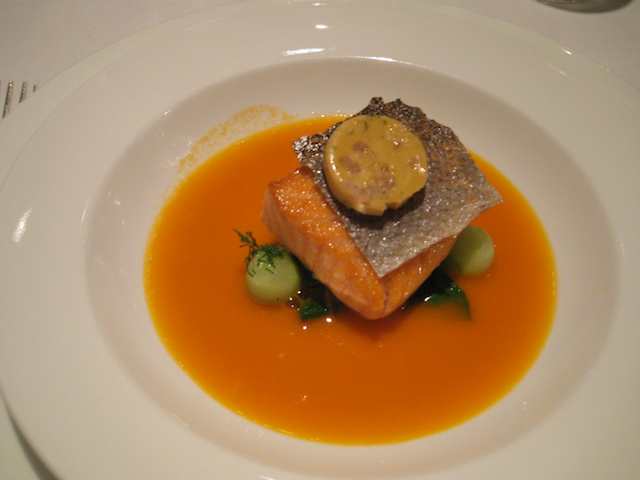
Baked organic salmon
Cucumber, smoked salmon bisque and potted shrimp butter
The salmon is from Scotland, with good oil in the flesh. Not as forceful as a BC Spring, a more reserved flavour.
The skin has been removed and crisped to a wafer and sugared. It’s topped by a a bit of roasted pureed garlic. Two melon balls hide under the skirts of the fish in the shallow pool of bisque.
And that bisque is excellent. They break down a whole salmon with shellfish and fish stock, and pass it thrice to thicken it. Would I be willing to sacrifice a salmon to work up a bisque like this? Maybe when I’m back in Vancouver with enough time to make a mess. This is an intensely satisfying broth.
The wine for this is a Rully, 2006 Maisieres, Dureuil Janthail, Burgundy. On its own, there’s not much of the berry in it, but with the fish it finds a way to wrap itself around the oils in the dish.
The wines have progressed very well. The Le Thil was an excellent opener, the Alsace appropriate with the soup, and the Jura is going to be a new favourite of mine. I must see if I can source some for Bangkok. And the burgundy is the appropriate match with this dish.
I was so overcome with satisfaction that I fouled up again, and failed to secure a picture of my next course, (and of the particularly savage looking knife they presented me with for this dish. Darn!).
Slow cooked breast of mallard,
honey glazed parsnips confit leg and bay leaf jus
This came as a pile of red duck flesh, lightly bleeding juice, perched atop a neck of shining parsnips, the confit leg shouldering in and supporting.
I’m always fond of duck. I did overhear from the waiter talking to the next table that the pork here is the highlight, and it saddens me to miss that, but I’m content with my mallard.
My wine was a second Burgundy, a Mercurey 1er cru “Les Naugues”, 2004 Raquillet. Again, an appropriate fit for the dish.
At this point it’s coming on 9 p.m. and all but two of the tables are taken. It’s been a good two hours of eating at this point. As the waiter explained at the start in introducing the menu “It may seem like a lot, but it is good for the duration.”
The service has been excellent. The sommelier, of course, I’ve praised, but the wait staff were all worth noting. The young lady who would bring out the plates for the head waiter was quite striking, holding a pose of stoic precision that would have made the Japanese satisfied.
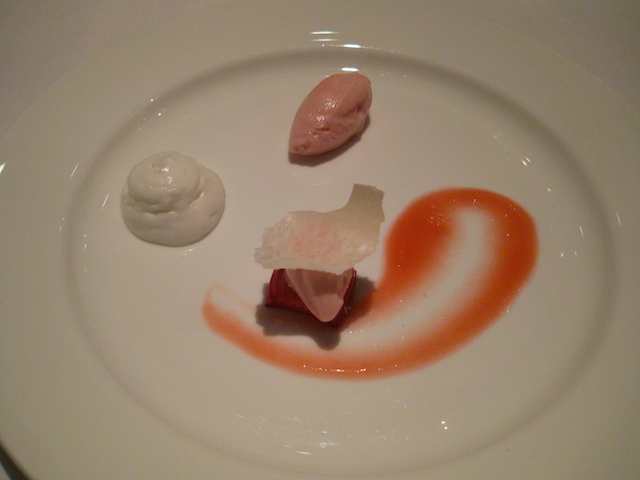
Rhubarb sorbet
The sorbet arrived, in keeping with the general theme of subtley the colours were pastels. The flavours were brightly accented though, with a bit of coconut ice cream, and the tartness of rhubarb in the sorbet. Under the race day hat of a crisp were strawberry and parfait.
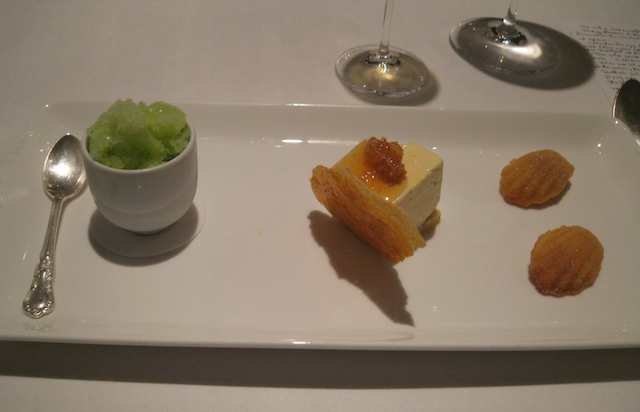
Apple parfait honeycomb,
granny smith granite and warm cinnamon madeleines
Soft, giving madeleines, a sweet parfait full of apple and honey, and the tang of green apple in the granite. A good combination.
And my final wine as a Coteaux du Layon, 2005 “Reblay”, Chateau La Tomaze, Loire, France, a sweet white for an easy finish.
At this point, I applauded myself for having passed on the cheese course. I’d seen my way through the duration, and had enjoyed myself immensely.
At least, I felt immense.
I thanked my sommelier in particular. He’d earned his salt this evening, not only doing an excellent job of pairings, but having enjoyed himself in the process.
And a last bit of whimsy, the bill is presented in a black envelope, as “The Damage”.

-
Day 3
Banteay Srei was one of the last temples we visited, and it was probably our favourite. Both my mother and I have a love for fine things (we don’t look it, but we really do!), and the carvings at Banteay Srei were far and away the most refined of all the temples.

I really liked Banteay Srei, too. The detailing there, and the smaller size puts it on much more of a human level.
I'm curious, how long did it take to get there now? I remember it being a bad road and taking most of a day to get there and back.
I think you should take your time with this piece, and really draw the best bits out slowly.

P.S. - The celebration of the first coconut is always an event to be enjoyed.
-
I'm sorry to have missed Kris' trip here last January. I have been away for a long time (RL can really make you forget about the good stuff here). Anyway, I'm still here in Korea. Peter, if you make it here in March, there is a fabulous kalbi restaurant that has opened here in my town. The beef is so tender and smoky plus the pork samgyeopsal beautifully marbled. The restaurant is owned by a former taxi driver who is a good friend of ours. We try to eat there every week. Just give a holler when you are here.
Any eGulleteer is welcome to (contact me). My email is doddiep@yahoo.com or just send me a PM. I'll be happy to meet up with you and treat you to a kalbi dinner or grilled pork intestine lunch.
Thanks, Doddie! I'll be in touch, with the Boy in tow this time.
-
Hello Peter,very interesting reading,I think you should start your own blog.
Your review of Great Queen Street is pretty much spot on.
They have spent zilch on the place,so it must be,extremely profitable,good luck to them.
We went for lunch,one Saturday about a month ago.
The place is very dark during he day and deemed ourselves fortunate to secure a window table,so we could watch the outside animation.
I kept the menu somewhere,but its not at hand ,at present,so I shall have to go from memory!
My recollection is one of comfort food,a pie for two,a bit of game,obviously a plate of fish.
I'm sure the menu change frequently,according to what is available.
We had a very scrummy dish of Braised Hare,a rather large portion,all the better for the generous amount of celery in the pot.
We added a side of mash and another of chunky kale to complete the package.
This was about as good as it gets for the type.
I had a guest ale,and my wife had a half carafe of house wine.?
The bill,a very reasonable£45.50 plus tip.
We were glad we did not have a starter,as we were so full we could not find place for a pud.
You are correct in following Food Snobs advice,he has his finger very firmly on the pulse
of the London dining scene.
Thanks, David.
I do feel bad about not having gone for the more representative "comfort" dishes, but I'm an eater, not a critic, and my appetite will drive my choices.
I do like their price point, and the flyer that I lifted advertised their Sunday lunch on the basis of "The menu will change weekly, here's what we did last time", so they are holding to good common sense and working with what is best available. (three courses for 25 STG and a cheese course at a reasonable 3 STG).
But, would I go back to face that seating again? (okay, it won't be my face in direct suffering, but you know what I mean). I think I'd more likely put my effort into a return to Arbutus or Hereford Road, or else try some of Food Snob's other recommendations.
As for a blog, I suspect that the discipline required would soon desert me. I'm better in these short spurts.
Cheers,
Peter
-
The Second Sitting – Part 4
We’d moved, at last. The event was over, and we migrated across town to the offices we keep off of Tottenham Court Road. Looking down on London from some 20 floors up gave me a vantage from which to sort out where I would be eating next.
Arbutus
I’d done without lunch (or breakfast) for the last several days out of necessity. I do actually work for a living. But today was one of those instances where they need me in two places at the same time. My answer was simple. I could lose an entire day traveling to and from Leeds, or we could bring Leeds to me.
Simple.
Now, I am of the mind that business is best addressed over a good meal. People are happy, they’re comfortable, and they’ll let slip items during small talk that they wouldn’t necessarily go over across a board room.
So, I’d made reservations for lunch at Arbutus, and my appointment would meet me there.
I’d come across Matthew Grant’s post on Arbutussome time back, and the menu had looked very good (at least back then). Then it had come up again in discussions closer to this trip
They were doing a good trade when I arrived, shortly before noon. I was escorted to the back, past the bar, and settled down to a small table looking out to the front so I would hopefully see my lunch guest upon his arrival.
Unfortunately, I was completely engrossed in the menu when he appeared at my table, inquiring if I was who I am.
We ordered.
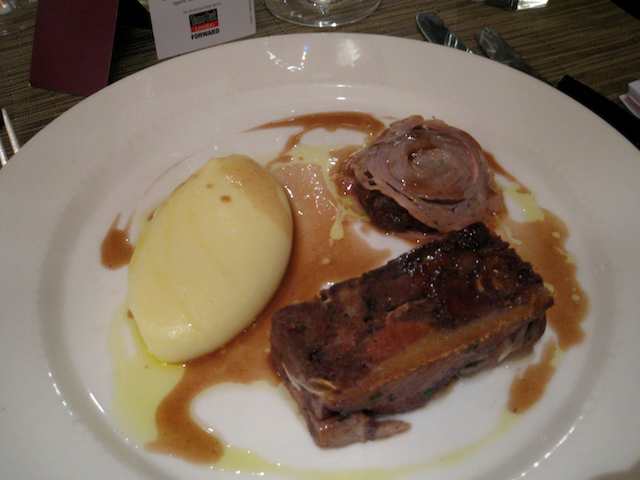
I began with the braised pigs head and potato puree. This came with a dollop of caramelized onion topped with a slice of brawn.
A very good opening, and suited to the weather outside. The braised pig was pully, yielding up those mysterious chunky bits you get with head.
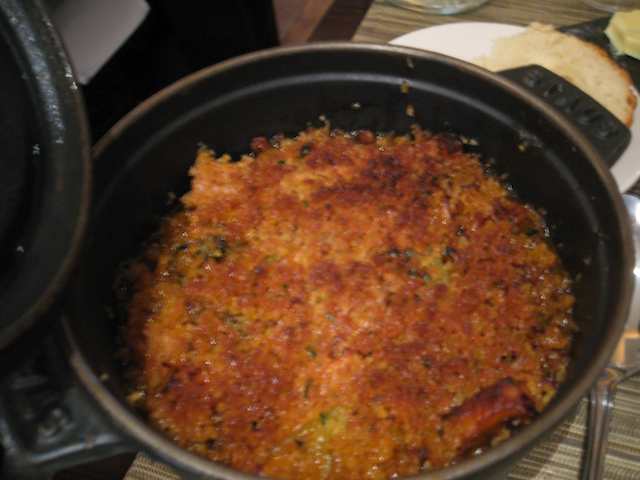
And, for the mains, a gratin of ox tripe. This came in a manly casserole dish, the sort you use both hands to carry. It was accompanied by an equally manly iron pot of more potatoes, smooth as silk, charged with a bit of brown gravy to stand up against the overt creaminess of the spuds.
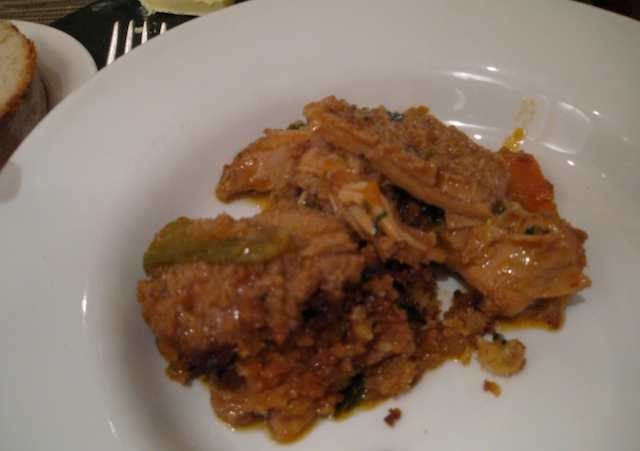
The tripe was very good. Soft and clean, the gratin giving a slight contrast in texture. This is a dish I’d love to do at home.
My companion was slightly amused that I was taking pictures of the food, and taking as many notes of what we ate as I did of what we discussed. But he was comfortable enough with the concept, and it actually made me appear relatively harmless, so all for the good.
The room was a little noisy. Lots of sharp corners, hard floors, and not much to muffle the sound (there’s a discussion in the eGullet thread I quoted on disappearing linen in London). But I wasn’t here for a romantic tete-a-tete, and I found rather that it lent a good buzz to the atmosphere.
Cashing out, I found Demetre’s book on the bar. I took a curious glance, and then pulled my wallet back out. The first recipe I saw, a cucumber gazpacho with smoked salmon, had me cold (sorry). The instructions are straightforward, while well written, with notes discussing the ingredients in enough detail to do me some good.

He’s very concerned with the ingredients (obviously) and puts some effort into explaining sustainable alternatives. A sensible approach, and much of this cookbook is about being sensible.
A very good meal. As with Hereford Road the night before, this was quite good value for the money, and I had none of my normal qualms regarding filing my expenses. My lunch companion was happy as he set off for the train back North, and I considered it all very much of a success.
We worked into the evening. Asked about my dinner plans, I told my team that I was going to feed upon dead animal flesh somewhere nearby. That was enough to whither their interests.
My plan for the evening, after a stop in at Foyle’s (I’ve always enjoyed rambling through this bookstore), was to try Food Snob’s other recommendation – Great Queen Street.

Hereford Road had been very good, and this fell into the same category, tracing a pedigree to St. John, and focusing on being a neighborhood restaurant. They’d opened this place after the Crown and Hope at Waterloo, having refit an old pub into a restaurant.
Great Queen Street was a bit longer than I’d expected, and I stopped at one of the shops that was just closing up to inquire as to which direction to look (I’d come into the middle). I should know better. I received the usual “This is Great Queen Street” and then had to explain that I was looking for the restaurant of the name. “No idea” said one affable fellow. “It’ll be around here somewhere.”
It was two doors down.
Having found it, I was disappointed. First, the seating. Small, hard, wooden stools (technically chairs, I suppose, as they did have backing). That sounds like a physician’s assessment, I know, but they were on the same level of discomfort. The tables, likewise, just barely accommodate the chairs, and I was having flashbacks to previous parent teacher meetings, the ones where they think it best to understand the child’s viewpoint by sitting at their desk. It’s just there’s a lot more of me than there was of my ten year old (they have gotten larger, though).
(I knew I’d seen these tables and chairs before! They’re from Chengdu's Beer Street!)
The benefit of tiny seating is, of course, that you can fit more of it in. And this they do, with the tables clustered such that, once seated, I don’t dare move for fear of toppling the meals of the other diners jammed in around me.
The menu hardly excites me. It’s quite limited, with nothing really outré to get my attention. The dishes that do look interesting (large cuts of meat) are for multiple diners, and, while I could just order and not finish, there’s a small gristle of morals left in me somewhere that would be outraged at wasting food.
And I’m still somewhat comfortable from the lunch.
The next disappointment is my own due. Not seeing anything on the meat side that I could either finish or enjoy, I opted for a light meal of shellfish. I say disappointment, as this hardly provides any grounds upon which to assess the kitchen.
But, I’m not a food critic, just a feeder, so I’ll eat as I please.
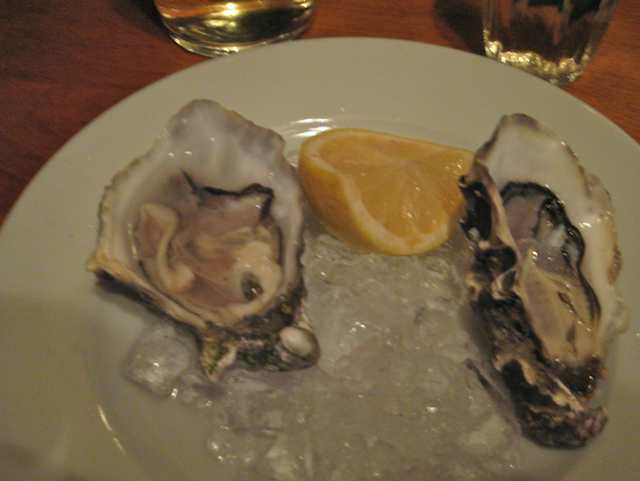
I start with a pair of oysters. These are fair representatives of their ilk; plump, but not to the point where you feel that you’re eating the results of a biopsy. I’ve not had oysters since Bangkok, and so these worked to take my mind off of my other issues.
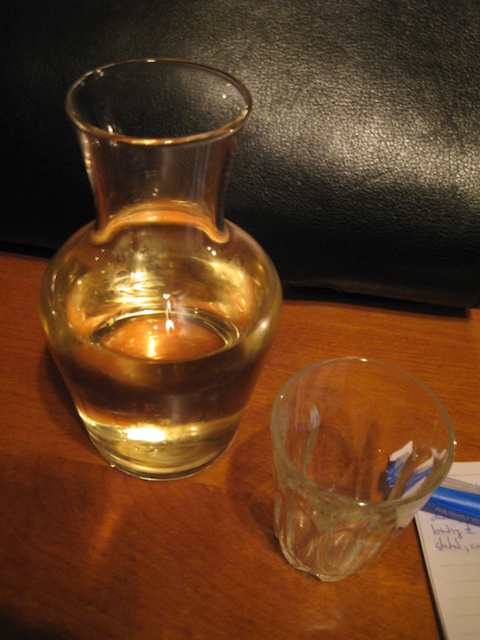
Another issue being the wine. Or, rather, not the wine itself, but it’s delivery. While I like their offering a variety of wines by the carafe, these kitchen tumblers are a pain. Yes, they’re quaint, but they don’t do much for me.
The service, however, I am quite happy with. Part of it is sympathy with their having to work through the hard corners of this dense seating arrangement. I know I’ll be bruised at some point when I try to negotiate my way out to the entrance. The staff smile, respond easily to my requests, and don’t impose while I’m eating.
I do note, though, that the table next to me gets a lot more information regarding the menu and the offerings than I did. The pheasant they describe sounds like it might have been a better choice for me, but I’m committed at this point.
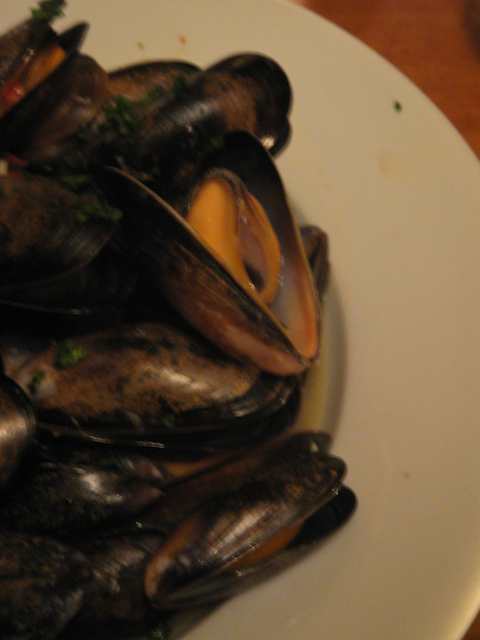
For a main I have the mussels. These are done in a faux Thai style, with ginger, garlic, and a hint of chilis. Not really much there in the flavourings, but the mussels themselves are very good, similar to the plump bits that I’d had at Rhodes’ the other night.
Across the way I see real wine glasses being brought to a table, along with a bottle in a bucket. I feel somewhat of an underclass.
I played Jenga with my shells, there not being any room for a separate dead bowl for the remnants.
In contrast to the dining area, the bar is an expanse of open space, with people lounging comfortably against it’s wooden expanse, chatting with the staff. I’d have done better to eat up there (although they didn’t appear to be serving food at the bar)
I toyed with the idea of some dessert (“pudding”) but I could feel my limbs seizing up. As gracefully as I could, I extricated myself from the Chinese torture of my table, and began the long walk back to my hotel, hoping to wear away a bit of what I'd packed on.
It's actually a pity that I'd worked so hard to isolate myself this evening, as many of the things I might have enjoyed on the menu required more than a singularity at the table.
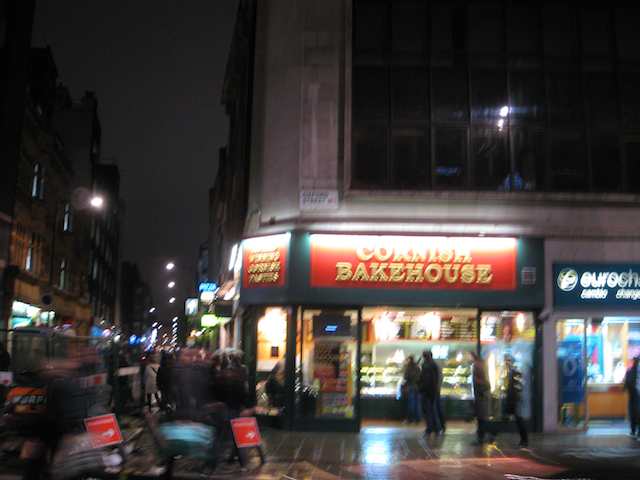
Pasties looked good, but I was spent for the day. There was work to be done on the morrow.



Cambodian/Khmer Cooking
in Elsewhere in Asia/Pacific: Cooking & Baking
Posted
And here's another take on Amok - aka Khmer fish stew
As Joannes says in introducing this dish, amok is the national dish of Cambodia. There are almost a limitless number of recipies, and you'll find these same ingredients in "soups, stews, and savory flans".
The first, most important part as Erin already illustrated, is making the kroeung, the curry paste.
Their recipe here is a little different (like amok, everyone has their own kroeung recipe). I'll give the details here:
3 tbsp oil
2 inches of galangal, peeled and shredded
2 inches of turmeric, peeled and shredded
(I was smarter and had our housekeeper do this. No yellow fingers for me)
2 inches of krachai, peeled and chopped (you can use garlic as a substitue, but it's not the same)
3 stalks of lemon grass, the bottom third, finely chopped
4 small red shallots, peeled and chopped
10 kaffir lime leaves, juliened
2 teaspoons prahok (anchovies to the rescue again)
The oil is heated in the wok, and then all of the ingredients are fired up to a golden brown. This is a tough call for me, as the turmeric imparts that tell-tale yellow so quickly that I go colour blind (or at least monochrome).
Man, though, that smells good when the ingredients all hit the hot oil.
From there, into the mortar to pound down into a paste. I get started in the mortar, and Yoonhi calls a halt and transfers me to the food processor. Something about it being difficult to get turmeric stains out of the ceiling......
The amok itself is pretty easy. I don't have the traditional nonni leaves, but the book recommends Swiss chard as a substitute.
I've picked up a hamour (grouper) which I like for the firmness of its flesh.
We heat another 3 tablespoons of oil in the wok, and then add the kroeung and fry it up to brown. Then we add the fish, and then the Swiss chard. Let the greens wilt, and add coconut milk, a teaspoon of palm sugar, and 4 tbsp of fish sauce.
Portion it out into some coconut bowls (at last, I can use them for something besides mojitos), and top with a bit of the coconut cream.
The flavour is a treat for Yoonhi. "There's something nutty in this." It must be the krachai. Smooth coconut broth, and nice, just cooked slices of fish. This "stew" version is fairly close to the first amok I ever had way back when in Siem Reab. If I was to do this again, I'd probably add a handful of basil at the finish to wilt in. If I could get fresh coconut to serve it in (with the white flesh to scrape out) that would take me right back to the flavour I remember.
I can do this again (but I also want to try the hor mok version, too, now that I've got spare kroeung around).